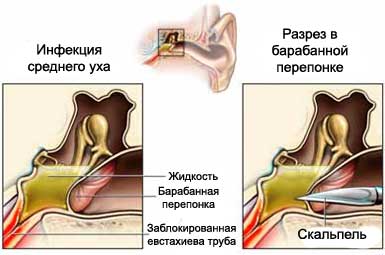Tympanotomy – Tympanostomy
Description myringotomy
Myringotomy is a procedure for making holes in the eardrum. This is to ensure, to drain fluid, which accumulates in the middle ear. Fluid, which merges – blood, pus and / or water. In many cases, a hole in the eardrum is inserted a small tube, It helps to maintain drainage. This surgery is most often done in children, but it is sometimes used to adults.
Reasons for myringotomy
Myringotomy may be accomplished:
- For the treatment of ear infections;
- To restore hearing loss, caused by the accumulation of fluid and to prevent delayed speech and possible hearing loss in a child;
- For, to take a sample of fluid from the middle ear, and examine it in the laboratory for the presence of bacteria or other infections;
- To place tympanostomy tube – This tube helps to equalize the pressure. It may also help prevent recurrent ear infections and the accumulation of fluid behind the eardrum.
After the procedure, pain and / or pressure in the ear due to fluid accumulation should be reduced. Hearing loss due to fluid accumulation must also disappear.
Possible complications of myringotomy
Complications are rare, but no procedure does not guarantee the absence of risk. Before, how to perform a myringotomy, you need to know about possible complications, which may include:
- Bleeding;
- Infection;
- Lack of effect after myringotomy;
- Hearing loss;
- Injury other organs of the ear, in addition to the eardrum;
- The need for reoperation.
How is myringotomy?
Preparation for the procedure
Your doctor may carry out or assign the following:
- Blood tests;
- Hearing test;
- Tympanograms – test, which measures, how well the eardrum responds to changes in pressure;
- Examine the outer ear and eardrum using an otoscope.
In the run-up to the procedure:
- We need to organize a trip for the operation and back home;
- Do not eat or drink anything for at least eight hours before the procedure;
Consult your doctor about the drugs taken. A week before surgery you may be asked to stop taking some medicines:
- Aspirin or other anti-inflammatory drugs;
- Blood thinners, such as warfarin, clopidogrel.
Anesthesia
The most commonly used general anesthesia. During surgery, the patient will sleep. In some cases, to numb the ear, It will use a local anesthetic.
Procedure myringotomy
The ear is introduced a small microscope, allowing the doctor a better view of its inner part. The eardrum is a tiny incision is made. The liquid is then drained from the middle ear. In most cases, a small tube is inserted into the cut. This will prevent drainage.
The incision in the eardrum heals itself, without intervention. This procedure is often done on both ears. Some methods can be used a laser beam, to make a hole in the eardrum.

How long will myringotomy?
The operation lasts about 15-20 minutes.
Will it hurt?
Anesthesia prevents pain during surgery. You may feel slight pain after surgery. The doctor may give pain medicine, to cope with the discomfort. Besides, They can be assigned to lidocaine eardrops, which will help reduce the pain.
If the operation was performed on both ears, you can feel the pulsation, pressure, or minor pain when chewing or yawning, While ear around the tube does not heal.
Care after myringotomy
After the procedure, be sure to follow your doctor's instructions, which may include:
- If the ear canal was put wool, to absorb the postoperative release, change it regularly. (Selections are or minimized during 2-3 days);
- If you get ear drops, you need to use them to their destination. You, usually, We should drip three drops in each ear, three times a day for three days after surgery;
- If the ear after surgery gets water, We need to monitor the evolution of the liquid. If the liquid appeared, you need to start using the ear drops as directed by a doctor, and if the selection continues for three days, consult a doctor;
- To speed up the healing process, You can return to normal activities as soon as possible;
- Take your medicines, as prescribed by your doctor;
- Use earplugs when showering or bathing, and avoid underwater swimming and diving without consulting your doctor;
- Do not drive, at least 3-4 day after surgery.
- Do not clean the ear after surgery, and do not put anything into it except for ear drops, wool, or earplugs, unless otherwise noted physician;
- Ask your doctor about, when it is safe to shower, bathe, or to expose the surgical site to water.
Complete healing without complications continues for four weeks. If the ear tubes were installed , they should fall within 6-12 months. In some cases, surgery may be necessary to remove the tube from the ear. Most eardrums, heal, usually, after removal of the drainage tube.
Contact your doctor after myringotomy
After returning home, you need to see a doctor, If the following symptoms:
- Signs of infection, including fever and chills;
- Redness, edema, increased pain, bleeding, or discharge from the ear;
- Pain, which does not pass after taking pain medication appointed;
- Isolation of liquid from the ear continues for more than four days after the operation;
- Hearing loss;
- Cough, breathlessness, chest pain, or severe nausea or vomiting;
- Any other painful symptoms.
